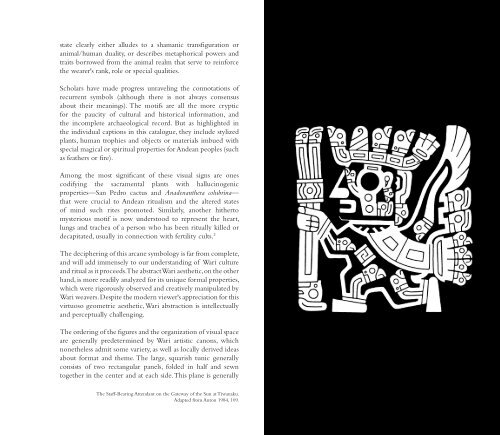You also want an ePaper? Increase the reach of your titles
YUMPU automatically turns print PDFs into web optimized ePapers that Google loves.
state clearly ei<strong>the</strong>r alludes to a shamanic transfiguration or<br />
animal/human duality, or describes metaphorical powers and<br />
traits borrowed from <strong>the</strong> animal realm that serve to reinforce<br />
<strong>the</strong> wearer's rank, role or special qualities.<br />
Scholars have made progress unraveling <strong>the</strong> connotations of<br />
recurrent symbols (although <strong>the</strong>re is not always consensus<br />
about <strong>the</strong>ir meanings). The motifs are all <strong>the</strong> more cryptic<br />
for <strong>the</strong> paucity of cultural and historical information, and<br />
<strong>the</strong> incomplete archaeological record. But as highlighted in<br />
<strong>the</strong> individual captions in this catalogue, <strong>the</strong>y include stylized<br />
plants, human trophies and objects or materials imbued with<br />
special magical or spiritual properties for Andean peoples (such<br />
as fea<strong>the</strong>rs or fire).<br />
Among <strong>the</strong> most significant of <strong>the</strong>se visual signs are ones<br />
codifying <strong>the</strong> sacramental plants with hallucinogenic<br />
properties—San Pedro cactus and Anadenan<strong>the</strong>ra colubrina—<br />
that were crucial to Andean ritualism and <strong>the</strong> altered states<br />
of mind such rites promoted. Similarly, ano<strong>the</strong>r hi<strong>the</strong>rto<br />
mysterious motif is now understood to represent <strong>the</strong> heart,<br />
lungs and trachea of a person who has been ritually killed or<br />
decapitated, usually in connection with fertility cults. 2<br />
The deciphering of this arcane symbology is far from complete,<br />
and will add immensely to our understanding of Wari culture<br />
and ritual as it proceeds. The abstract Wari aes<strong>the</strong>tic, on <strong>the</strong> o<strong>the</strong>r<br />
hand, is more readily analyzed for its unique formal properties,<br />
which were rigorously observed and creatively manipulated by<br />
Wari weavers. Despite <strong>the</strong> modern viewer's appreciation for this<br />
virtuoso geometric aes<strong>the</strong>tic, Wari abstraction is intellectually<br />
and perceptually challenging.<br />
The ordering of <strong>the</strong> figures and <strong>the</strong> organization of visual space<br />
are generally predetermined by Wari artistic canons, which<br />
none<strong>the</strong>less admit some variety, as well as locally derived ideas<br />
about format and <strong>the</strong>me. The large, squarish tunic generally<br />
consists of two rectangular panels, folded in half and sewn<br />
toge<strong>the</strong>r in <strong>the</strong> center and at each side. This plane is generally<br />
The Staff-Bearing Attendant on <strong>the</strong> Gateway of <strong>the</strong> Sun at Tiwanaku.<br />
Adapted from Anton 1984, 109.<br />
37







